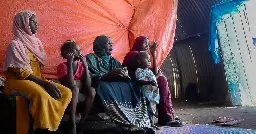Sudan Internal Displacement Set to Top 10 Million as Famine Looms
Sudan Internal Displacement Set to Top 10 Million as Famine Looms
Port Sudan, 6 June – The International Organization for Migration (IOM) is warning that the number of people displaced by conflict inside Sudan could top 10 million in the coming days. The world’s worst internal displacement crisis continues to escalate, with looming famine and disease adding to the...

Port Sudan, 6 June – The International Organization for Migration (IOM) is warning that the number of people displaced by conflict inside Sudan could top 10 million in the coming days. The world’s worst internal displacement crisis continues to escalate, with looming famine and disease adding to the havoc wrought by conflict.
IOM's Displacement Tracking Matrix, which issues weekly statistics, recorded 9.9 million people internally displaced across all 18 states in Sudan this week – 2.8 million prior to the April 2023 war, and 7.1 million since. More than half of all internally displaced persons (IDPs) are women, and over a quarter are children under the age of five.
“Imagine a city the size of London being displaced. That’s what it’s like, but it’s happening with the constant threat of crossfire, with famine, disease and brutal ethnic and gender-based violence,” said IOM Director General Amy Pope. “Humanitarian needs in Sudan are massive, acute and immediate, and yet only 19 per cent of the funds we have asked for have been delivered. Unified international efforts are required to avoid a looming famine.”
In total, some 12 million have been forced to flee their homes in Sudan, with more than 2 million crossing borders into neighbouring countries, principally to Chad, South Sudan, and Egypt.
After years of protracted crisis, full-scale civil war erupted in mid-April 2023 when fierce fighting between the Sudan Armed Forces (SAF) and the Rapid Support Forces (RSF) broke out in the capital Khartoum, and quickly expanded across the huge country, home to nearly 50 million people.
The brutality and intensity of the war are relentless, with reports of grave violations of human rights including ethnic violence, rape and gang rape as tools of war. Seventy per cent of the people forced to move in Sudan are now trying to survive in places that are at risk of famine. Humanitarian access is patchy or non-existent. The upcoming rainy season will complicate this and may lead to climate-related disasters and the spread of disease.
Last week, the Inter-Agency Standing Committee (IASC), the highest-level humanitarian coordination forum of the United Nations system, issued a stark warning that the situation in Sudan had reached catastrophic levels.
In Al Fasher, the capital of North Darfur, the intensifying conflict has left more than 800,000 civilians trapped in what the IASC called “a merciless onslaught of fighting and aerial bombardments.” Essential infrastructure, including health care, has collapsed. Prices of food, water and fuel have skyrocketed, making these basic essentials unaffordable.
“Crucial roads out of Al Fasher are blocked, preventing civilians from reaching safer areas, while at the same time limiting the amount of food and other humanitarian aid coming into the city,” added Othman Belbeisi, IOM’s Regional Director for the Middle East and North Africa. “We join the United Nations in calling for an immediate end to the fighting and the guarantee of safe, unimpeded and sustained humanitarian access across the borders and across frontlines. Millions of lives depend on it.”